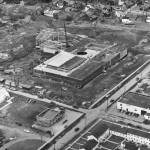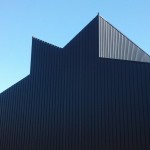The Contemporary Art + Design Wing houses not only beautiful light-filled galleries displaying works in contemporary glass, but the new 500-seat Amphitheater Hot Shop for live glassblowing demonstrations. Although it has been fitted with the latest and greatest in glassmaking equipment, the space pays homage to its deep roots in glassmaking, dating back more than 60 years.

Steuben Factory Workers (CMGL 166351). Collection of the Rakow Research Library, The Corning Museum of Glass, Corning, New York, photo courtesy of Constance Stuart Larrabee.
Steuben Glass opened in Corning in 1903, moving from its original factory on what is now Denison Parkway in downtown Corning to a building in the new complex of the Corning Glass Center in 1951. The Glass Center was comprised of the Steuben Glass factory, science and technology exhibits, and a new institution called The Corning Museum of Glass.
“This is a story about connection,” said Rob Cassetti, senior director, creative services and marketing for The Corning Museum of Glass. “It’s sacred ground. The Steuben Glass factory (which closed in 2011) was the last glassblowing factory here in this valley. But that story didn’t end.”
Cassetti became a designer for Steuben Glass in 1987, but first visited the factory a decade earlier as a college intern working for Corning Incorporated in a model shop. He often made plaster models for the Steuben designers, and one day, he was invited to see the space, which included the Robertson Ventilator blowing room, known as the “hot end” of the factory.
“It had this spiritual quality about it, and felt like a cathedral to me,” Cassetti said. “Walking into the space was a rush—the roar of the furnaces, the activity of the hot glass. It made the hair stand up on my neck.”
When Cassetti later gave tours of the Steuben factory, visitors were often struck by the beautiful steel structure of the building. Years later, architect Thomas Phifer would feel exactly the same way.
- Construction of Steuben Glass factory in 1951.
- The Amphitheater Hot Shop today.
“Tom said he wanted to retain as much of the original structure as possible and to make that the expression of the building,” Cassetti said. “There are construction pictures taken back in ’51 that look very much like the pictures taken during this expansion period. We took it back to the original building frame, then reinforced and rebuilt it to meet modern building codes.”
The flow of the new wing is very deliberate, a poetic journey through the process of understanding, appreciating, and making glass. Visitors enter the Museum in the Admissions Lobby, a public, bustling space where there are cash registers and people coming and going, Cassetti said. But when you step into the gallery space, you leave that all behind and are transported to this world of art.
“Tom Phifer made going through the galleries a spiritual experience,” said Cassetti. “There’s a purity to that space. It’s white and light. The curvilinear walls somehow speak to nature. The colorful objects are beautiful and complete. The building is so minimal and all of the details are reduced. You don’t see the light switches on the walls or vents in the floor. They’ve worked hard to make all of that go away.
“Then you cross over the threshold into the Amphitheater Hot Shop and it’s the exact opposite,” he continued. “It’s black. It’s industrial. Every part, piece, bolt, and screw is exposed. The structure of the building is fully expressed. It’s like a child’s drawing of how you hold up a building. You’re in the belly of the beast, and you’ve come to where glassmaking begins.”
Since 1951, the space has been used for glassmaking and to give visitors an opportunity to see the glassmaking process. As part of the original Corning Glass Center tour, people could sit on the 90-seat bleachers and look into the Steuben blowing room. The factory, however, would shut down for weeks in the summer, and rarely operated on weekends. The Museum’s Hot Glass Show was born in the 1990s as a way to provide consistent, reliable glass demonstrations to Museum visitors. The new wing has taken that same idea, but amplified it into a space that can now seat 500.
A handful of people involved in the Museum’s hot glass programs today trace their glassblowing roots back to the Steuben blowing room.

Drawing with Steuben Factory, courtesy of the Corning Incorporated Department of Archives & Records Management, Corning, NY.
“When I look at our glass demonstration programs, and all of the things we’re doing, we are building on what we learned from our masters,” Cassetti said. “This is a place of teaching, and it connects us all the way back to our teachers that worked here. On these shoulders we stand. There’s a rebirth in this space, and I think it’s tremendously powerful.”



1 comment » Write a comment